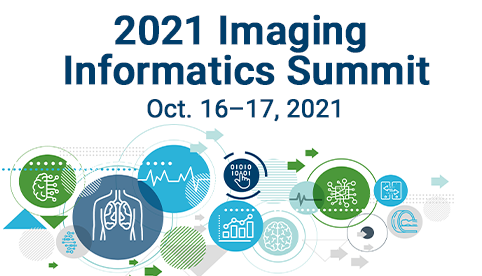Implementing Your AI and Informatics Strategic Road Map

Purchasing AI Products, Benefits of AI, Data Science, Economics of AI, Future of AI
Informatics today has moved far beyond its infancy in the 1990s, progressing well beyond early radiology machine learning of the 2010s. There are now widely used, FDA-cleared tools with associated real-world clinical data and outcomes. Our central focus for this year’s virtual ACR Imaging Informatics Summit will be the outcomes-driven implementation of informatics at a mature, operational level.
The summit will run immediately after and concurrently with the ACR Quality and Safety Conference, for those interested in attending both. With two expert keynote speakers, multiple CME didactic sessions, and interactive breakout sessions, this year’s summit promises to serve up the insights and opportunities you need to manage AI projects and be prepared for what’s next.
Discover the trends and dive into important topics
At the Imaging Informatics Summit, we will cover the most recent advancements in machine learning/AI and its impact on healthcare and radiology, as well as other equally important topics in informatics, including:
• Cybersecurity in this age of ransomware and denial of service attacks
• Enterprise-level integration of the imaging sphere using increasingly complex and interconnected medical record systems
• The informatics-owned digitalization of business intelligence
• Quality and safety assurance
• Clinical decision support
• Interoperability/scalability of operations
Sharing experiences with successful implementation, monitoring, and iteration is a key goal this year. To frame the discussion — and provide some perspective on what’s to come — this year’s keynote speakers, Greg Moore, MD, Corporate Vice President at Microsoft Health and Life Sciences, and Melissa Chen, MD, Neuroradiologist at MD Anderson Cancer Center and recent Chair of the ACR Commission on Patient- and Family-Centered Care Economics Committee, will give us the latest on how successful informatics approaches can drive better patient outcomes and informatics-related return on investment.
Valuable first-hand experiences demonstrate new approaches
Insightful, current explanation, analysis, and prediction is at the heart of the summit. Participants will be able to see first-hand how the broad suite of informatics tools provided by the ACR can be translated into practice at their own clinical sites, including using the ACR AI-LAB to federate algorithms onto their own premises and maintain control and use of proprietary data.
Leading vendors in the informatics space will be onsite to demonstrate the use and value of their informatics tools, including:
• Marketplace-type solutions to navigate the third-party-tool landscape
• Single-company multi-algorithm suites to serve a variety of clinical use cases
• Enterprise informatics approaches related to traditional informatics issues such as cybersecurity, EMR integration, clinical decision support, department-wide dashboards, and custom analytics
For those ACR members and others interested in the imaging informatics domain, this year’s ACR Imaging Informatics Summit will encapsulate the current state of affairs, spark provocative and thoughtful discussion on a wide range of topics, and help position attendees to succeed in deploying and carrying through their own ambitious AI and informatics strategic road map. Don’t miss out. Register today.
Juan C. Batlle, MD, MBA, Chief of Thoracic Imaging, Baptist Health | Chief of Radiology, Doctors Hospital | Associate Professor, FIU College of Medicine
Implementing Your AI and Informatics Strategic Road Map
-

You may also like
Key Takeaways from the Data Science SummitAugust 13, 2021 | Po-Hao (Howard) Chen, MD, MBAAs radiologists, we strive to deliver high-quality images for interpretation while maintaining patient safety, and to deliver accurate, concise reports that will inform patient care. We have improved image quality with advances in technology and attention to optimizing protocols. We have made a stronger commitment to patient safety, comfort, and satisfaction with research, communication, and education about contrast and radiation issues. But when it comes to radiology reports, little has changed over the past century.